The global 1550nm LiDAR pulsed fiber laser market is valued at USD 89.5 million in 2025 and is slated to reach USD 826.7 million by 2035, recording an absolute increase of USD 737.2 million over the forecast period. This translates into a total growth of 824%, with the market forecast to expand at a compound annual growth rate (CAGR) of 24.9% between 2025 and 2035. The overall market size is expected to grow by approximately 9.24X during the same period, supported by increasing demand for autonomous vehicle systems, growing adoption of advanced sensing technologies across automotive and industrial markets, and rising preference for high-precision distance measurement solutions across commercial and defense applications.
The 1550nm LiDAR pulsed fiber laser market represents an emerging segment of the global photonics and automotive technology industry, characterized by rapid technological advancement and expanding commercial applications. Market dynamics are influenced by accelerating autonomous vehicle development, growing industrial automation requirements, and expanding integration of advanced sensing systems in consumer and commercial vehicles. Traditional laser technology applications are evolving as manufacturers seek higher precision, extended range capabilities, and enhanced safety performance in complex operating environments.
Consumer and industrial adoption in the 1550nm LiDAR market reflects broader trends toward automated systems, enhanced safety protocols, and precision measurement technologies that provide both operational efficiency and advanced sensing capabilities. The market benefits from the growing integration of artificial intelligence and machine learning technologies, which enable sophisticated object detection, environmental mapping, and real-time decision-making processes. The versatility of 1550nm wavelength technology for long-range detection and superior atmospheric penetration supports sustained demand across multiple application categories and industry segments.
Regional development patterns vary significantly, with Asian markets showing strong preference for advanced automotive technologies and industrial automation systems, while North American and European markets demonstrate increasing adoption of autonomous vehicle platforms alongside established defense and aerospace applications. The competitive landscape continues to evolve with specialized photonics companies gaining market position through innovative laser designs, integrated sensing solutions, and comprehensive system integration capabilities, reflecting industry willingness to invest in next-generation sensing technologies for competitive advantage.
The competitive environment features established laser technology manufacturers alongside emerging specialized companies that focus on automotive-grade systems and precision measurement applications. Manufacturing efficiency and technological innovation remain critical factors for market participants, particularly as performance requirements and cost optimization pressures continue to intensify across automotive and industrial sectors. Distribution strategies increasingly emphasize direct partnerships with original equipment manufacturers and system integrators who require validated performance characteristics and comprehensive technical support for complex integration projects.
Market expansion trends indicate that larger technology companies are developing internal capabilities while forming strategic partnerships with specialized laser manufacturers to access advanced sensing technologies and accelerate product development timelines. Private research and development investments have gained momentum as companies seek to establish technological leadership while maintaining competitive cost structures for high-volume manufacturing applications. The emergence of eye-safe laser systems, including 1550nm wavelength solutions, reflects changing safety requirements and creates new market opportunities for manufacturers focused on automotive and consumer applications with enhanced safety profiles and regulatory compliance capabilities.
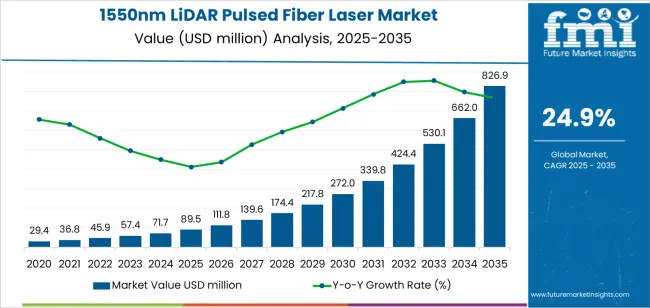
Between 2025 and 2030, the 1550nm LiDAR pulsed fiber laser market is projected to expand from USD 89.5 million to USD 271.9 million, resulting in a value increase of USD 182.4 million, which represents 24.7% of the total forecast growth for the decade. This phase of development will be shaped by increasing adoption of autonomous vehicle systems, rising demand for advanced sensing technologies, and growing emphasis on eye-safe laser solutions with enhanced range capabilities. Technology manufacturers are expanding their production capabilities to address the growing demand for automotive-grade laser systems, industrial sensing applications, and specialized defense solutions across commercial channels.
| Metric | Value |
|---|---|
| Estimated Value (2025E) | USD 89.5 million |
| Forecast Value (2035F) | USD 826.7 million |
| Forecast CAGR (2025–2035) | 24.90% |
From 2030 to 2035, the market is forecast to grow from USD 271.9 million to USD 826.7 million, adding another USD 554.8 million, which constitutes 75.3% of the overall ten-year expansion. This period is expected to be characterized by the expansion of autonomous vehicle deployment, the integration of advanced manufacturing technologies, and the development of next-generation laser systems with enhanced performance characteristics and reduced manufacturing costs. The growing adoption of eye-safe wavelength technologies will drive demand for 1550nm systems with superior range capabilities and compatibility with automotive safety standards across commercial vehicle operations.
Between 2020 and 2025, the 1550nm LiDAR pulsed fiber laser market experienced accelerated growth, driven by increasing investment in autonomous vehicle development and growing recognition of advanced sensing technologies as critical components for transportation safety and industrial automation applications. The market developed as automotive manufacturers recognized the potential for laser-based systems to provide enhanced object detection, precise distance measurement, and reliable performance while enabling advanced driver assistance protocols and autonomous navigation capabilities. Technological advancement in fiber laser design and wavelength optimization began emphasizing the critical importance of maintaining eye safety standards and performance consistency in diverse operating environments.
Market expansion is being supported by the increasing global demand for autonomous vehicle technologies and the corresponding need for advanced sensing solutions that can provide superior detection capabilities and safety characteristics while enabling precise environmental mapping and extended operational range across various automotive and industrial applications. Modern automotive manufacturers and technology integrators are increasingly focused on implementing eye-safe laser systems that can deliver exceptional performance against challenging environmental conditions, enable reliable object detection, and provide consistent measurement accuracy throughout complex operational scenarios and diverse atmospheric conditions. 1550nm wavelength technology's proven ability to deliver extended range capabilities against atmospheric interference, enable safe operation around human operators, and support high-precision measurement systems make them essential components for contemporary automotive and industrial sensing applications.
The growing emphasis on autonomous vehicle deployment and advanced manufacturing automation is driving demand for 1550nm LiDAR systems that can support large-scale commercial requirements, improve safety outcomes, and enable sophisticated environmental sensing capabilities. Industry preference for technologies that combine effective long-range detection with eye-safe operation and reliable performance characteristics is creating opportunities for innovative laser system implementations. The rising influence of artificial intelligence integration and machine learning applications is also contributing to increased demand for 1550nm systems that can provide high-quality sensor data, enhanced detection accuracy, and reliable performance across extended operational periods.
The 1550nm LiDAR pulsed fiber laser market is poised for rapid growth and transformation. As automotive manufacturers across North America, Europe, Asia-Pacific, and emerging markets seek technologies that deliver exceptional sensing accuracy, eye-safe operation, and extended range capabilities, 1550nm laser systems are gaining prominence not just as sensing components but as strategic enablers of autonomous vehicle deployment and advanced manufacturing automation.
Rising autonomous vehicle adoption in Asia-Pacific and expanding industrial automation initiatives globally amplify demand, while manufacturers are leveraging innovations in fiber laser design, wavelength optimization systems, and integrated sensing technologies.
Pathways like automotive integration solutions, industrial sensing applications, and specialized defense systems promise strong margin uplift, especially in high-performance sensing segments. Geographic expansion and technology diversification will capture volume, particularly where safety requirements and precision measurement adoption are critical. Regulatory support around automotive safety standards, eye-safe laser requirements, and autonomous vehicle certification give structural support.
The market is segmented by peak power, application, wavelength band, end-use sector, integration level, and region. By peak power, the market is divided into Less Than 4 kW, 4-6 kW, 6-10 kW, and Above 10 kW categories. By application, it covers Passenger Car and Commercial Vehicle segments. By wavelength band, the market includes Standard 1550nm, Enhanced 1550nm, and Specialized 1550nm. By end-use sector, it comprises Automotive OEMs, Tier-1 Suppliers, Industrial Manufacturers, and Defense Contractors. By integration level, the market is categorized into Component, Module, and System categories. Regionally, the market is divided into North America, Europe, East Asia, South Asia & Pacific, Latin America, and the Middle East & Africa.
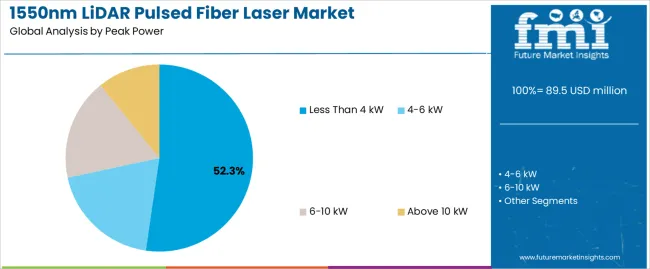
The less than 4 kW segment is projected to account for 52.3% of the 1550nm LiDAR pulsed fiber laser market in 2025, reaffirming its position as the leading peak power category. Automotive manufacturers and system integrators increasingly utilize lower power laser systems for their superior eye safety characteristics when operating in consumer vehicle environments, excellent energy efficiency properties, and widespread acceptance in applications ranging from passenger car sensing to commercial vehicle automation systems. Lower power laser technology's advanced safety protocols and cost-effective integration capabilities directly address the automotive industry requirements for mass production feasibility in complex manufacturing environments.
This power segment forms the foundation of modern automotive sensing patterns, as it represents the configuration with the greatest safety compliance and established market acceptance across multiple vehicle categories and sensing applications. Manufacturer investments in cost reduction and performance optimization continue to strengthen adoption among automotive suppliers and system integrators. With automotive companies prioritizing safety compliance and manufacturing efficiency, lower power systems align with both regulatory requirements and economic constraints, making them the central component of comprehensive automotive sensing strategies.
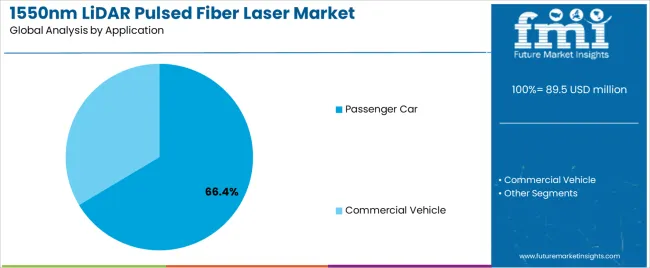
Passenger car applications are projected to represent 66.4% of 1550nm LiDAR demand in 2025, underscoring their critical role as the primary deployment channel for automotive sensing systems across consumer vehicle production, advanced driver assistance integration, and autonomous vehicle development applications. Passenger car manufacturers prefer 1550nm systems for their exceptional safety characteristics, reliable performance capabilities, and ability to enhance vehicle automation while ensuring consistent detection accuracy throughout diverse driving conditions and operational scenarios. Positioned as essential components for modern passenger vehicle safety systems, 1550nm lasers offer both sensing performance advantages and regulatory compliance benefits.
The segment is supported by continuous innovation in cost reduction technologies and the growing availability of automotive-grade systems that enable mass production requirements with enhanced performance uniformity and reduced manufacturing complexity. Passenger car manufacturers are investing in advanced sensing systems to support large-scale vehicle production and autonomous capability development. As autonomous vehicle technology becomes more prevalent and safety requirements increase, passenger car applications will continue to represent a major deployment market while supporting advanced automotive integration and safety enhancement strategies.
The 1550nm LiDAR pulsed fiber laser market is advancing rapidly due to increasing demand for autonomous vehicle systems and growing adoption of advanced sensing technologies that provide superior detection capabilities and eye-safe operation while enabling precise environmental mapping across diverse automotive and industrial applications. The market faces challenges, including high development costs, complex integration requirements, and the need for specialized manufacturing expertise and quality validation programs. Innovation in fiber laser design and integrated sensing systems continues to influence product development and market expansion patterns.
The growing adoption of autonomous vehicle platforms, advanced driver assistance systems, and industrial automation technologies is enabling manufacturers to produce sophisticated 1550nm laser systems with superior sensing capabilities, enhanced safety characteristics, and reliable performance functionalities. Advanced fiber laser systems provide improved detection accuracy while allowing more efficient integration workflows and consistent performance across various automotive applications and environmental conditions. Manufacturers are increasingly recognizing the competitive advantages of eye-safe wavelength capabilities for market differentiation and automotive compliance positioning.
Modern 1550nm laser producers are incorporating innovative manufacturing processes, automated production systems, and cost reduction capabilities to enhance product competitiveness, enable mass production formats, and deliver value-added solutions to automotive customers. These technologies improve manufacturing efficiency while enabling new market opportunities, including automotive integration, high-volume production, and reduced system costs. Advanced manufacturing integration also allows producers to support comprehensive automotive supply chains and market expansion beyond traditional specialized applications.
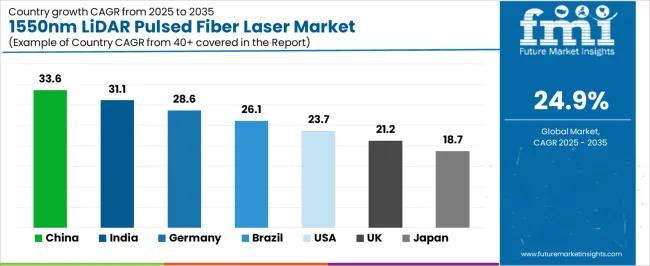
| Country | CAGR (2025–2035) |
|---|---|
| China | 33.60% |
| India | 31.10% |
| Germany | 28.60% |
| Brazil | 26.10% |
| United States (USA) | 23.70% |
| United Kingdom (UK) | 21.20% |
| Japan | 18.70% |
The 1550nm LiDAR pulsed fiber laser market is experiencing rapid growth globally, with China leading at a 33.6% CAGR through 2035, driven by expanding automotive manufacturing capabilities, growing autonomous vehicle development programs, and significant investment in advanced sensing technology development. India follows at 31.1%, supported by increasing automotive production capacity, growing technology integration initiatives, and expanding electronics manufacturing infrastructure. Germany shows growth at 28.6%, emphasizing automotive innovation excellence and advanced manufacturing technology development. Brazil records 26.1%, focusing on expanding automotive sector capabilities and technology integration modernization. The USA demonstrates 23.7% growth, prioritizing autonomous vehicle development and advanced sensing technology leadership. The UK exhibits 21.2% growth, emphasizing automotive technology advancement and specialized sensing system development. Japan shows 18.7% growth, supported by automotive technology leadership and precision manufacturing capabilities.
The report covers an in-depth analysis of 40+ countries, the top-performing countries are highlighted below.
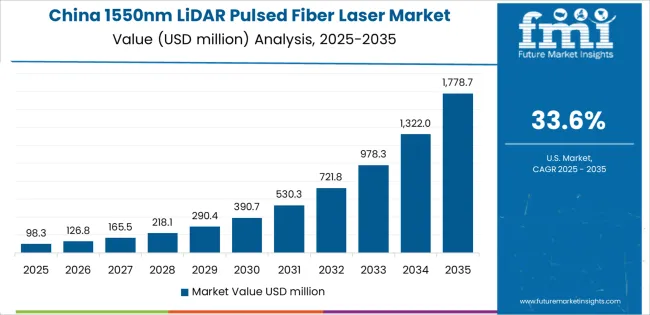
Revenue from 1550nm LiDAR pulsed fiber lasers in China is projected to exhibit exceptional growth with a CAGR of 33.6% through 2035, driven by expanding automotive manufacturing capabilities and rapidly growing autonomous vehicle development supported by government initiatives promoting advanced transportation technology development. The country's strong position in electronics manufacturing and increasing investment in automotive technology are creating substantial demand for advanced sensing systems. Major automotive manufacturers and technology companies are establishing comprehensive production capabilities to serve both domestic vehicle production demand and expanding export markets.
Revenue from 1550nm LiDAR pulsed fiber lasers in India is expanding at a CAGR of 31.1%, supported by the country's growing automotive manufacturing sector, expanding electronics production capabilities, and increasing adoption of advanced technology systems. The country's initiatives promoting manufacturing modernization and growing technology investment are driving requirements for advanced sensing components. International suppliers and domestic manufacturers are establishing extensive production and technology development capabilities to address the growing demand for automotive sensing systems.
Revenue from 1550nm LiDAR pulsed fiber lasers in Germany is expanding at a CAGR of 28.6%, supported by the country's automotive technology leadership, strong emphasis on manufacturing innovation, and robust demand for advanced sensing systems in automotive and industrial applications. The nation's sophisticated automotive sector and technology development capabilities are driving advanced laser system adoption throughout the manufacturing industry. Leading automotive companies and technology suppliers are investing extensively in sensing technologies and advanced manufacturing systems to serve both domestic and international markets.
Revenue from 1550nm LiDAR pulsed fiber lasers in Brazil is growing at a CAGR of 26.1%, driven by the country's expanding automotive manufacturing sector, growing technology integration programs, and increasing investment in advanced vehicle systems development. Brazil's large automotive market and commitment to manufacturing advancement are supporting demand for diverse sensing solutions across multiple vehicle categories. Manufacturers are establishing comprehensive technology integration capabilities to serve the growing domestic automotive market and expanding manufacturing opportunities.
Revenue from 1550nm LiDAR pulsed fiber lasers in the USA is expanding at a CAGR of 23.7%, supported by the country's advanced automotive technology sector, strategic focus on autonomous vehicle development, and established technology integration capabilities. The USA's automotive innovation leadership and advanced sensing technology development are driving demand for specialized laser systems in autonomous vehicle, defense, and advanced manufacturing applications. Manufacturers are investing in comprehensive technology development to serve both domestic automotive markets and international technology applications.
Revenue from 1550nm LiDAR pulsed fiber lasers in the UK is growing at a CAGR of 21.2%, driven by the country's focus on automotive technology advancement, emphasis on innovation development, and strong position in specialized technology applications. The UK's established automotive technology capabilities and commitment to advanced sensing development are supporting investment in laser sensing technologies throughout major automotive and technology regions. Industry leaders are establishing comprehensive technology integration systems to serve domestic automotive development and specialized technology applications.
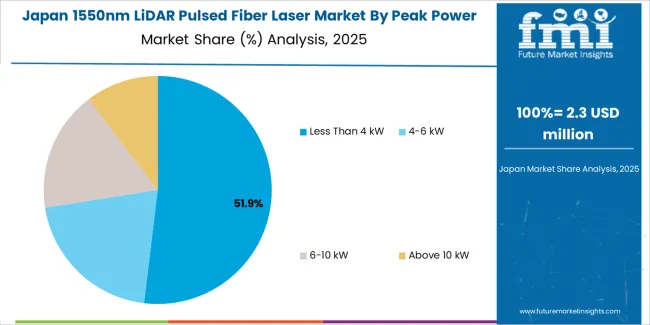
Revenue from 1550nm LiDAR pulsed fiber lasers in Japan is expanding at a CAGR of 18.7%, supported by the country's automotive technology excellence, growing precision manufacturing sector, and strategic emphasis on advanced sensing technology development. Japan's advanced manufacturing capabilities and integrated automotive systems are driving demand for high-precision laser systems in automotive, industrial, and specialized technology applications. Leading manufacturers are investing in specialized capabilities to serve the stringent requirements of automotive and precision manufacturing industries.
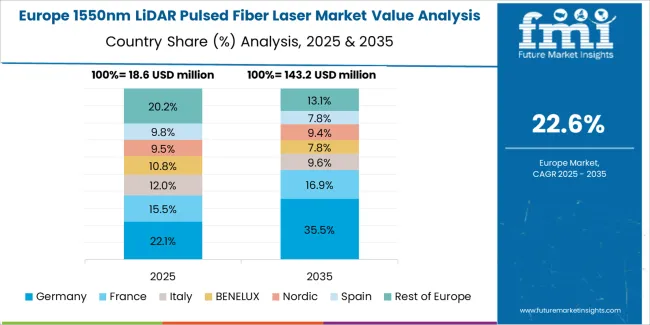
The 1550nm LiDAR pulsed fiber laser market in Europe is projected to grow from USD 17.9 million in 2025 to USD 165.4 million by 2035, registering a CAGR of 25.1% over the forecast period. Germany is expected to maintain its leadership position with a 41.2% market share in 2025, increasing to 43.8% by 2035, supported by its strong automotive technology leadership, sophisticated sensing system development capabilities, and comprehensive automotive industry serving diverse 1550nm laser applications across Europe.
France follows with a 18.3% share in 2025, projected to reach 17.9% by 2035, driven by robust demand for advanced automotive technologies in autonomous vehicle applications, technology development programs, and specialized sensing markets, combined with established automotive manufacturing infrastructure and technology integration expertise. The United Kingdom holds a 14.7% share in 2025, expected to reach 14.2% by 2035, supported by strong automotive technology sector and growing advanced sensing development activities. Italy commands a 11.8% share in 2025, projected to reach 11.4% by 2035, while Spain accounts for 8.2% in 2025, expected to reach 7.9% by 2035. The Netherlands maintains a 3.1% share in 2025, declining to 2.8% by 2035. The Rest of Europe region, including Nordic countries, Eastern Europe, Belgium, Poland, and other nations, is anticipated to maintain momentum, with its collective share moving from 2.7% to 2% by 2035, attributed to increasing automotive technology development in Eastern Europe and growing advanced sensing adoption in Nordic countries implementing automotive innovation programs.
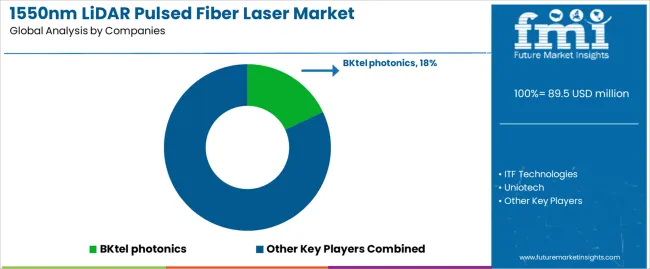
The 1550nm LiDAR pulsed fiber laser market is characterized by competition among specialized photonics companies, automotive technology suppliers, and integrated sensing system providers. Companies are investing in fiber laser research, wavelength optimization, advanced manufacturing system development, and comprehensive product portfolios to deliver consistent, high-performance, and application-specific 1550nm laser solutions. Innovation in eye-safe wavelength systems, automotive integration capabilities, and performance enhancement is central to strengthening market position and competitive advantage.
BKtel photonics leads the market with a strong market share, offering comprehensive fiber laser solutions including advanced wavelength systems and precision manufacturing processes with a focus on automotive and specialized sensing applications. ITF Technologies provides specialized laser systems with an emphasis on high-performance capabilities and innovative integration solutions. Uniotech delivers comprehensive technology development with a focus on automotive applications and cost-effective manufacturing systems. LD-PD specializes in precision laser components and advanced wavelength optimization for sensing applications. Evolase focuses on automotive-grade systems and innovative performance solutions. Lumispot offers specialized sensing systems with emphasis on industrial and automotive integration capabilities.
| Item | Value |
|---|---|
| Quantitative Units (2025) | USD 89.5 million |
| Peak Power Range | Less Than 4 kW; 4–6 kW; 6–10 kW; Above 10 kW |
| Application | Passenger Car; Commercial Vehicle |
| Wavelength | Standard 1550nm; Enhanced 1550nm; Specialized 1550nm Band |
| End-Use | Automotive OEMs; Tier-1 Suppliers; Industrial Sector Manufacturers; Defense Contractors |
| Integration Level | Component; Module; System Level |
| Price Segment | Premium; Mid-range; Economy |
| Regions Covered | North America; Europe; East Asia; South Asia & Pacific; Latin America; Middle East & Africa |
| Countries Covered | China; India; Germany; Brazil; United States; United Kingdom; Japan; and 40+ additional countries |
| Key Companies Profiled | BKtel Photonics; ITF Technologies; Uniotech; LD-PD; Evolase; Lumispot |
| Additional Attributes | Dollar sales by peak power and application category; regional demand trends; competitive landscape; technological advancements in fiber laser systems; automotive integration development; wavelength optimization; sensing system integration |
The global 1550nm lidar pulsed fiber laser market is estimated to be valued at USD 89.5 million in 2025.
The market size for the 1550nm lidar pulsed fiber laser market is projected to reach USD 826.9 million by 2035.
The 1550nm lidar pulsed fiber laser market is expected to grow at a 24.9% CAGR between 2025 and 2035.
The key product types in 1550nm lidar pulsed fiber laser market are less than 4 kw, 4-6 kw, 6-10 kw and above 10 kw.
In terms of application, passenger car segment to command 66.4% share in the 1550nm lidar pulsed fiber laser market in 2025.






Full Research Suite comprises of:
Market outlook & trends analysis
Interviews & case studies
Strategic recommendations
Vendor profiles & capabilities analysis
5-year forecasts
8 regions and 60+ country-level data splits
Market segment data splits
12 months of continuous data updates
DELIVERED AS:
PDF EXCEL ONLINE
LiDAR in Mapping Market Size and Share Forecast Outlook 2025 to 2035
LiDAR Drone Market Size and Share Forecast Outlook 2025 to 2035
Mobile LiDAR Scanner Market Size and Share Forecast Outlook 2025 to 2035
Radar & LiDAR Technology for Railways - Trends & Forecast 2025 to 2035
Solid State LiDAR Sensor Market Analysis Size and Share Forecast Outlook 2025 to 2035
Boundary Layer Wind Lidar Market Size and Share Forecast Outlook 2025 to 2035
Laser Transverse Mode Teaching Instrument Market Forecast and Outlook 2025 to 2035
Laser Welding Equipment Market Forecast and Outlook 2025 to 2035
Laser Welding Market Size and Share Forecast Outlook 2025 to 2035
Laser Ablation Systems Market Size and Share Forecast Outlook 2025 to 2035
Laser Measurement Integrating Sphere Market Size and Share Forecast Outlook 2025 to 2035
Laser Safety Cloths Market Size and Share Forecast Outlook 2025 to 2035
Laser Dazzler Market Size and Share Forecast Outlook 2025 to 2035
Laser Cable Marking Market Size and Share Forecast Outlook 2025 to 2035
Laser Cladding Market Size and Share Forecast Outlook 2025 to 2035
Laser Marking Equipment Market Size and Share Forecast Outlook 2025 to 2035
Laser Cutting Machines Market Size and Share Forecast Outlook 2025 to 2035
Laser Wire Marking Systems Market Size and Share Forecast Outlook 2025 to 2035
Laser Photomask Market Size and Share Forecast Outlook 2025 to 2035
Laser Measuring Instrument Market Size and Share Forecast Outlook 2025 to 2035

Thank you!
You will receive an email from our Business Development Manager. Please be sure to check your SPAM/JUNK folder too.
Chat With
MaRIA